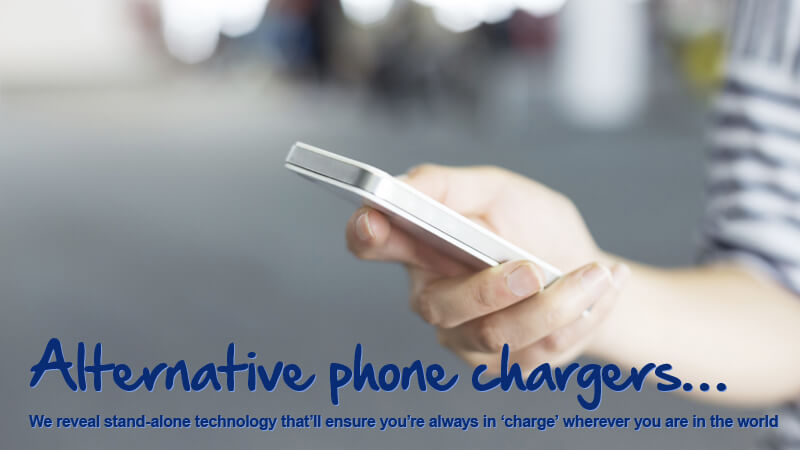
Stay in charge – stay connected
Suffering from ‘connectivity’ anxiety as you prepare to head off on holiday or business? From flat-lining data coverage to a deceased battery in your mobile… read our lifesaving guide to off-grid phone chargers that’ll ensure you always stay in ‘charge’ wherever you travel.
From keeping your phone powered with the latest off-grid chargers to ensuring your data keeps streaming – we’ve all the details you need to ease your online travel anxiety…
Here’s what you need
Click below to visit the technology you’re interested in…
| Solar Harness the sun’s rays Kinetic Capture your own energy Water Turn water to power | Crank Get winding for power Thermo Cook and charge Battery Ever ready power |
Alternative energy phone chargers
It’s not always possible for travellers to find a plug socket to give their mobile a quick shot of power, but that doesn’t mean they can’t harness natural power to fuel a connection…
What’s on offer: If you can’t find a traditional power socket, then battery packs are a great solution to keep your mobile charged – but what happens when they run flat? This is when alternative chargers can fill the void. Here we look at the alternative technology available and how it could keep you connected…
SOLAR POWER CHARGERS
First we look at chargers that harness the power of sun – something that should be plentiful as we head for beaches and slopes around the world… but can it really keep our phones brimmed with power?
Solar pros: Many chargers are small, portable and able to work in overcast conditions as well as clear sunshine. There’s no manual power required and most have internal batteries that can be charged when not in use. Power is free and plentiful.
Solar cons: Charging times are often lengthy and overcast conditions will increase these even further.
Our pick of solar phone chargers: Here’s a selection of our favourite solar phone chargers.
Solar Monkey Adventurer
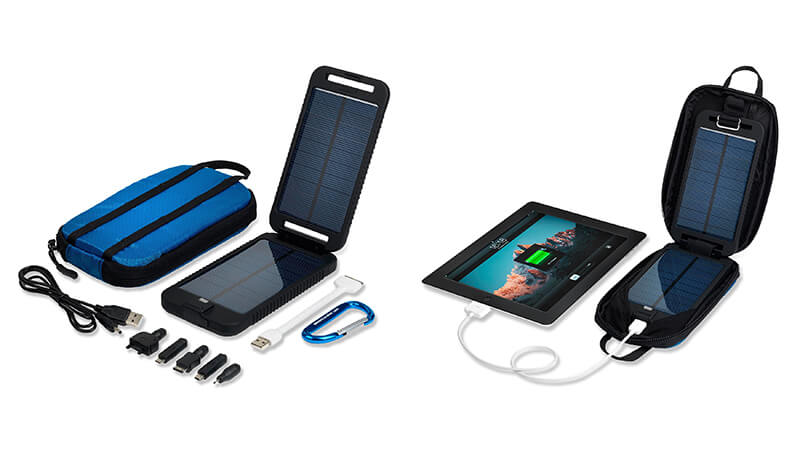
Solar Monkey Adventurer
Designed with the likes of Apple in mind, this lightweight device includes an internal battery that can be used to charge a device while simultaneously being topped up with power via the solar panel. The unit can also be strapped to a backpack to make the most of daylight hours when you’re out and about. An attractive and effective solar charging device that’ll keep your phone running during off-grid periods.
Smartphone charge time: In optimum light conditions the solar panel will fully charge its internal batteries in just 8-10 hours… allowing you to harvest energy during the day, then power your phone overnight. However, the internal battery and solar panel can be combined for fast daytime charging.
Verdict: A rugged and portable piece of kit that’s sure to keep your battery cells tickled. Plenty of adapters and the ability to strap to a backpack up its credentials, too. It’s not the cheapest, though.
How much: £85.50
Where: Find out more and buy here
Voltaic Off-Grid 6W Solar Backpack
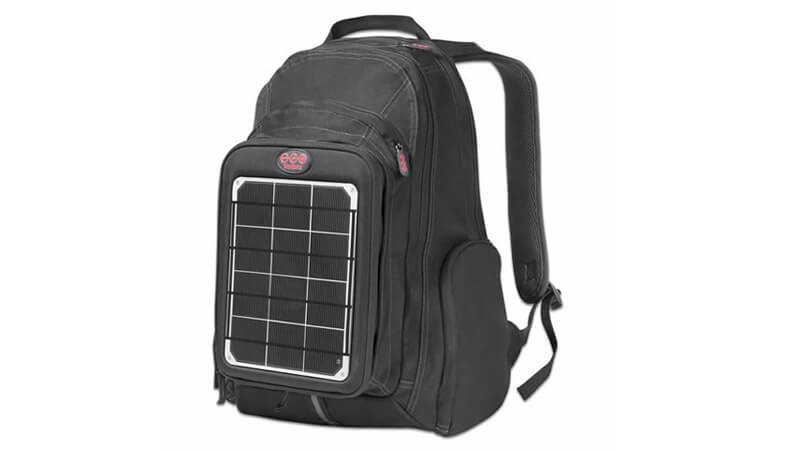
Voltaic Off-Grid 6W Solar Backpack
An impressive charging solution for all types of travellers, this backpack has an integrated solar panel to keep gadgets and smartphones charged wherever you are. The sturdy backpack can create 6W of output through a standard USB socket along with providing a useful 25-litres of load space. It’ll take around three hours of sunshine to charge a smartphone, but there’s also a powerful 4,000mAh battery that can be continually charged throughout the day
Smartphone charge time: Up to three hours directly from the panel, but charging from the solar-powered internal battery pack will make this far quicker.
Verdict: We all need a bag, so combining this with a solar panel makes perfect sense and provides a great back-up to keep you connected.
How much: £154.99
Where: Check out the deal here
Freeloader Pro
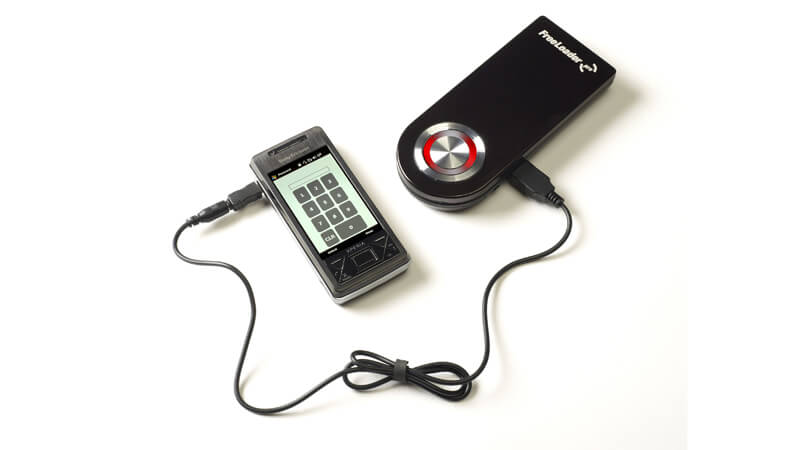
Freeloader Pro
This rugged charging unit is ideal for powering phones, sat-navs and many other devices. The solar panels can charge the internal 1600mAh battery in around 7 hours of direct sunshine. Once fully charged the battery is said to be capable of providing up to 70 hours of standby time for your mobile. The Freelaoader Pro comes with 10 adapters that are compatible with everything from smartphones to DVD players and walkie talkies.
Smartphone charge time: There are no details on charging times direct from the panel, but powering the internal battery should take around 7 hours.
Verdict: One of the most versatile solar chargers around – and great value, too. A useful back-up for any mobile-connected traveller.
How much: £34.99
Where: Order your Freeloader Pro here
Poweradd Apollo 2
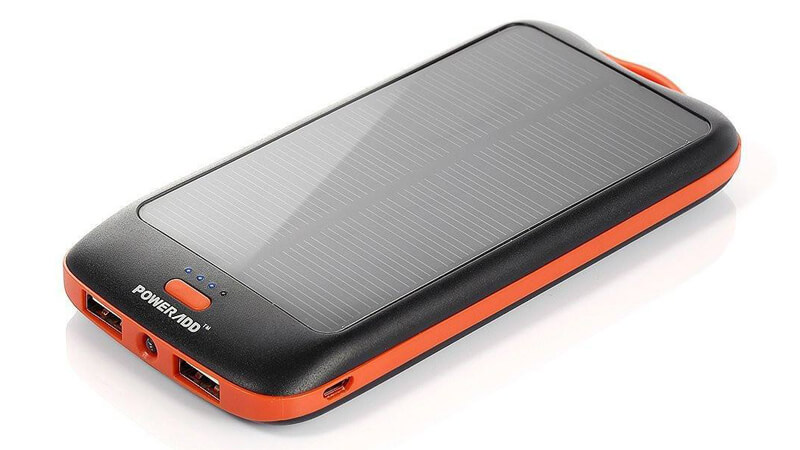
Poweradd Apollo 2
If you’re looking for an ultra-portable solar charger, this is the unit. Despite being no bigger than a smartphone, the Appollo 2 can pack enough juice to recharge an iPhone up to four times. Additionally, it has two USB outlets allowing for simultaneous charging of two devices. It’s compatible with most smartphones – not to mention Kindles. However, the small solar panel needs up to 50 hours to fully charge the internal battery. This shouldn’t be a problem if you give it a full charge before leaving the ‘grid’, then top it up during daylight hours. Note: you have to buy the adapter for Apple.
Smartphone charge time: No details on direct phone charging times but starting with a full battery and topping up with harvested solar power means smartphones can be charged overnight and kept operational several days.
Verdict: It’s one of the smallest units available and has a decent internal battery that’s powerful enough to charge your phone overnight if it’s topped up using solar power during daylight hours.Great value, too.
How much: £19.99
Where: Get your Poweradd Apollo 2 here
SunJack 14W
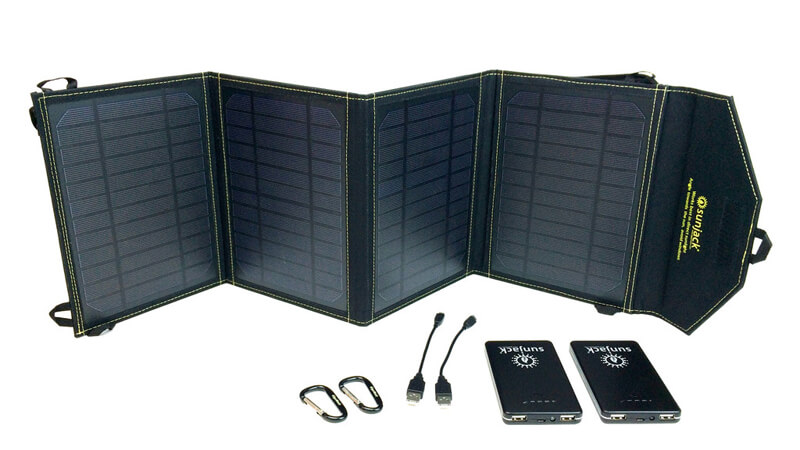
SunJack 14W
The four-panel unit folds to around the size of an iPad and can fully charge its battery in just five hours. This is one of the fastest units available and has been reported to recharge an iPhone in around 90 minutes – that’s comparable with traditional wall chargers. The four-panel design also gives enough muscle to pack energy for to power four smartphones or one tablet after just five hours of sunlight. There’s a more powerful sibling that can fuel eight phones after the same five-hour charge time.
Smartphone charge time: The four solar-munching panels can get your phone fully charged in just 90 minutes.
Verdict: If you’re serious about staying connected, this is the unit that really does what you need, when you need it. Perfect for beach, camping or just about any travel location.
How much: £99.95
Where: Get your SunJack 14W
Voltaic Systems 4.0W
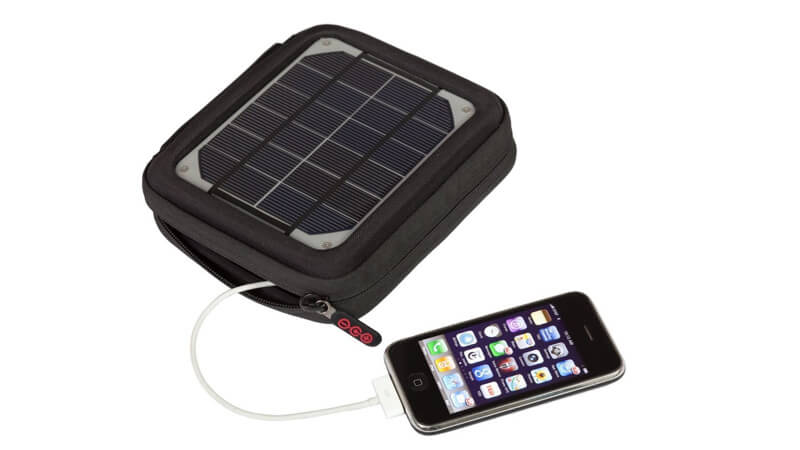
Voltaic Systems 4.0W
Another of our favourites, the Voltaic Systems 4.0W offers dual solar panels capable of charging most smartphones with 3.5 hours of indirect sunlight – while 60 minutes of the hot stuff is reported to generate enough fuel for up to three hours’ use. The removable battery also creates the option to buy a spare so one can charge your phone while the other’s harvesting more solar power. As with other units, the battery can also be charged from a USB port. Comes in a wallet format. Height 1.8 inches x length 6.7 inches x; Weight 1.2 pound; Width 5.2 inches
Smartphone charge time: Charge your phone in just 3.5 hours of indirect sunlight.
Verdict: If the reports are accurate, this solar unit offers a viable option for savvy travellers who need to stay on the radar.
How much: £89.99
Where: Get your Voltaic solar charger here
CRANK-POWERED CHARGERS
Next we look at phone chargers employing the human body as a power source to share with our beloved phones. Read on to see if elbow grease really can offer a viable solution.
Crank-powered pros: Portable and work anywhere without the need for sun or additional kit. Endless power supply – in theory. Additionally, some devices have internal batteries.
Crank-powered cons: Chargers without internal batteries will require you to crank while making a call or attempting to use the internet.
Our pick of crank-powered phone chargers: Here’s a selection of our favourite people-powered phone chargers.
CrankMonkey
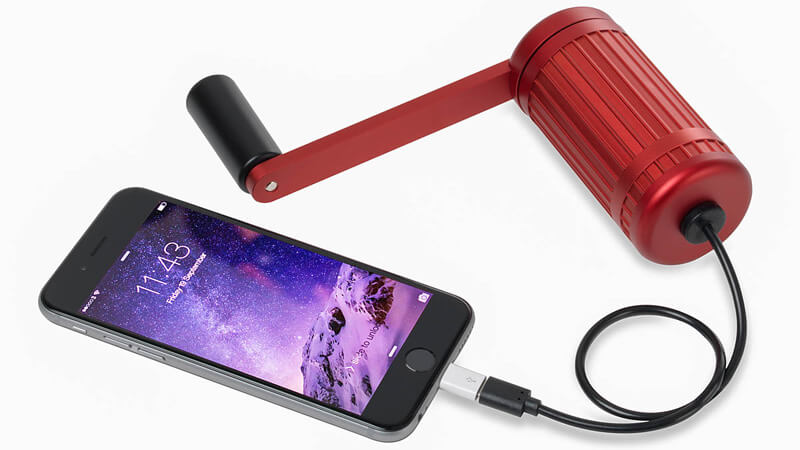
CrankMonkey
Despite looking like a coffee grinder, the Powertraveller PowerMonkey is a new hand-cranked portable power source that’ll ensure you’re never left with a dead battery for long. Just plug in and crank – with the manufacturers claiming the 5V unit produces enough juice to power a call after two minutes of winding with 10 minutes of elbow grease offering up to 20 minutes of talk and browsing time. There’s no internal battery, so you’ll need to crank to add power directly to the device. The CrankMonkey is waterproof rated to IP65 standards, charges 5V devices using a micro USB output and weighs 346g with dimensions of 150 x 96 x 45mm.
Smartphone charge time: Around an hour of solid cranking should provide a good charge, while 10 minutes should be sufficient for 20 minutes of browsing or talking.
Verdict: It certainly isn’t a budget option, but it’s a robust unit with decent gearing. Anyone who’s going to be off-grid for a reasonable amount of time – walkers or climbers – will find this a must-have piece of emergency kit.
How much: £99.50
Where: Get your CrankMonkey right here
Eton BoostTurbine 2000
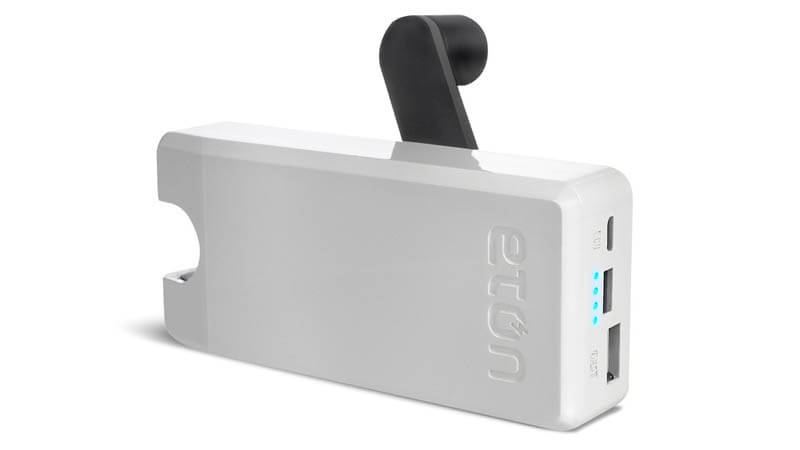
Eton BoostTurbine 2000
This unit offers a 2000mAh battery pack to charge your phone while on the move, but also a hand crank that can be used to top up the battery or send power directly to your phone. The company says that four minutes of cranking will provide enough power for around one minute of talk time at two turns a second. Charging a phone simply by cranking will probably not be an option, but combined with the internal battery, it offers a solid option for anyone who needs to ensure they won’t be left with a completely unusable phone.
Smartphone charge time: No definitive time for charging a device by cranking alone, but it’s probably best employed as an emergency back-up. A full charge from the battery should last around 9 hours.
Verdict: The battery and hand-crank make a practical combination for anyone who’s going to be away from charging facilities for a day or so – providing that extra bit of reassurance.
How much: £34.85
Where: Buy here
SOSCharger

SOSCharger
Another power supply that comes with an internal battery and self-powered generator to ensure you’re never left without the ability to make a call or browse online. The 2,300mAh battery can charge your device in the normal way, while the hand-crank can then be used to top it up when away from a regular power source. The generator has a longer handle than many units – making it easy to crank – and an indicator telling you just how much power you’ve created.
Smartphone charge time: It’s debatable about how long it’d take to fully charge your phone, but the manufacturers claim just 3-5 minutes of cranking will reward you with up to 12 minutes of talk or browsing time.
Verdict: An impressive dual-power device that looks good and provides a practical solution for emergency charging. It’s reasonably priced, too.
How much: £42 (approx.)
Where: Get your charger right here
Ampware Phone Case crank charger (iPhone 6 only)
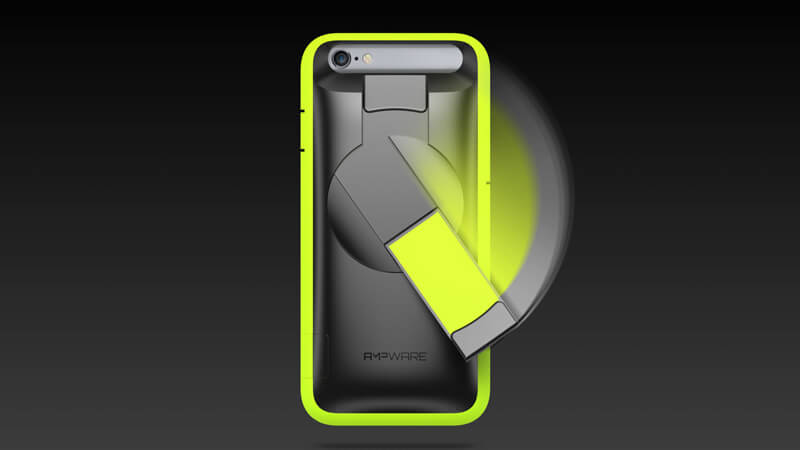
Ampware Phone Case crank charger
It might look like a slightly chunky phone case, but the Ampware device is actually a stand-alone charger, too. The case has a built in hand crank that can give you up to one hour’s standby time and around 20 minutes talk and browsing in return for just five minutes of cranking time. Sadly, it’s only available for iPhone 6 and 6s at the moment. There’s no internal battery, but the impressive crank-to-power ratios would seem to make this less of a problem.
Smartphone charge time: There’s no data on whether you could fully charge your phone, but with five minutes cranking claimed to produce up to 20 minutes of talk time, the possibility of continuous off-grid browsing time looks a real possibility.
Verdict: If the crank-to-charge times really are accurate, this could certainly be the ideal accessory for iPhone users who need to know they’ll always have connectivity.
How much: £55 (approx, plus shipping)
Where: Pre-order now for delivery from mid-March.
Tigra Sport Bike Charge Dynamo

Ampware Phone Case crank charger
Planning a cycling holiday? This wheel-mounted phone charger could be the perfect partner to ensure your power-hungry apps are kept running with help from your very own pedal power. Easily attached to most spoked (front) wheels, the unit has a built-in 1000mAh battery that can charge your devices and be topped up as you cycle. The low-resistance generator starts to work at 5kmh and hits optimum efficiency at around 20kmh. It offers easy DIY installation and doesn’t require any tools – making it great for bikes hired while on holiday. It also includes LED front and rear lights – with high-beam, low-beam and flash modes. Comes with changeable flanges to fit different front hub profiles.
Smartphone charge time: The manufacturers claim it will fully charge most mobiles within 2-3 hours’ riding.
Verdict: If the charge times are accurate, such a device could prove invaluable for cyclists using energy-zapping performance, health and navigational apps while on the go.
How much: £60
Where: Get your Bike Charge Dynamo here
KINETIC-POWERED CHARGERS
Here we look at a charger that can capture and recycle energy that your body burns while doing everyday tasks or exercise. It’s currently a small category, but we’re sure it’s one that’ll grow.
Kinetic-powered pros: Whenever we move, we use energy, so harnessing this is a great way to gather power from everyday tasks such walking on the beach or going for a jog.
Kinetic-powered cons: Not the technology of choice for phone-surfing couch potatoes.
Our pick of kinetic-powered phone chargers: Here’s a selection of our favourite people-powered phone chargers.
Ampy
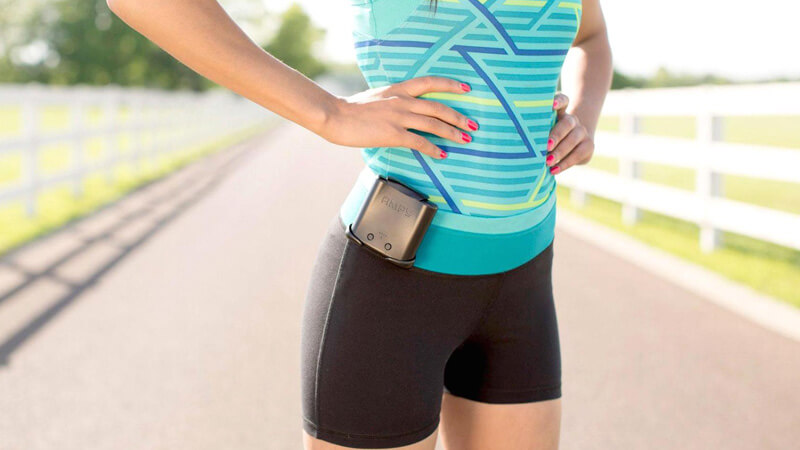
Ampy
If you’re going out for a jog, walking in the hills, cycling or doing just about anything that involves movement, taking the Ampy along will help claw back some of that precious energy you’re expending. Along with an 1,800mAh internal battery, the Ampy’s also hiding two inductors, which can convert your movement into power to top up the battery. For added interest, there’s an accompanying app that will tell you just how much power you’ve created and added to your battery.
Smartphone charge time: According to the manufacturers, just one hour of exercise will generate enough power for an hour of browsing and talking, or five hours of standby time. Walking your daily 10,000 steps or cycling for an hour could also add around three hours of standby time.
Verdict: A great piece of kit for any active travellers who need to stay in touch.
How much: £70 (approx, plus shipping)
Where: Buy Ampy here
THERMO-POWERED CHARGERS
If you’re heading out into the wilds on a camping or walking trip, using these two heat-powered devices could help your phone-charging anxieties just melt away…
Thermo-powered pros: No need for sun or physical exertion, this tech will work virtually anywhere. Excellent for camping and walking trips.
Thermo-powered cons: The equipment will add additional weight to anyone travelling by foot. Will require fuel – such as wood or camping stove.
Our pick of thermo-powered phone chargers: Here’s a selection of our favourite thermo-powered phone chargers.
Biolite Camping Stove
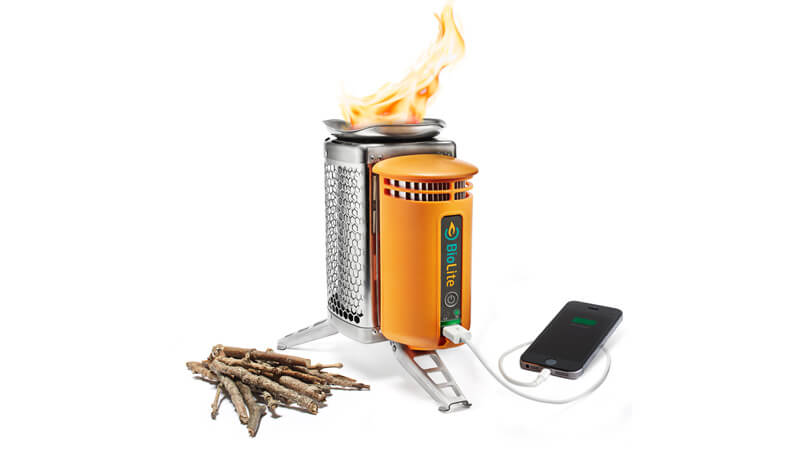
Biolite Camping Stove
The perfect kit for intrepid travellers who might occasionally stray beyond the confines of their hotel room. Whether in the middle of the Australian outback – or having a barbie on a beach in Benidorm, you’ll never go hungry or fall from the cellular radar with this Biolite Campstove. The Campstove base unit uses a high-tech set of self-powered internal fans to improve combustion and deliver smoke-free flames in minutes – but it can also divert surplus electricity to charge smartphones and other such devices. You won’t need to take fuel with you, either; the stove unit is powered by twigs and scraps of wood you can find just lying around.
Smartphone charge time: Fully charging a phone will take around two hours, but 20 minutes of burn time translates to 60 minutes of talk time.
Verdict: A good-looking device that has impressive charge times. Certainly worth the investment for anyone who’s heading for the wilderness…
How much: £108.95
Where: Place your order here
Power Pot 5
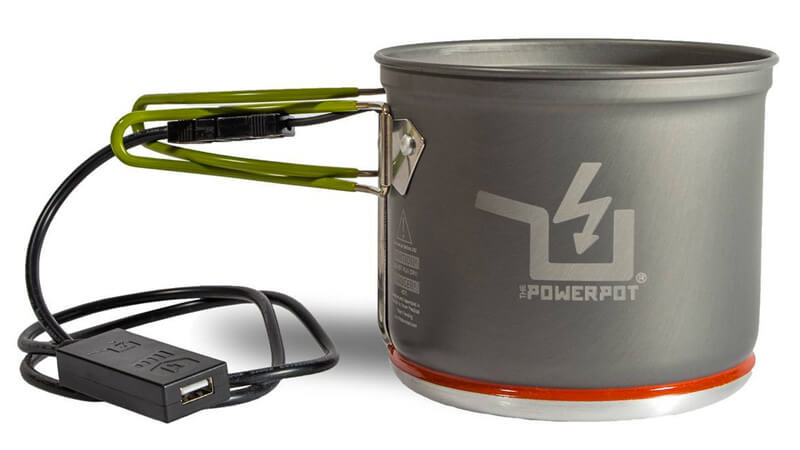
Power Pot 5
Just like the Biolite stove, the Power Pot converts heat to energy to charge your phone and similar devices. However, unlike the Biolite, you’ll need to supply a separate heat source – such as a camping stove or camp fire. You’ll also need to fill it with water – or soup, stew etc. – during operation. A great way to feed yourself and your phone!
Smartphone charge time: Once again, it’ll take around two hours of roaring flames to cook up a full charge for your phone, but it’ll start charging virtually instantly if you just need a quick top up. There’s also a 10W version which can cut charging times to 60-90 minutes.
Verdict: Not quite as fun to look at as the Biolite stove, but this is a highly practical piece of kit for anyone who’s heading off the grid.
How much: £123.95
Where: Get yours here
WATER-POWERED CHARGERS
Here we take a look at chargers powered by the plentiful, but not necessarily free, resource of water…
Water-power pros: Special pods are filled with water to activate battery cells to produce power. No worry of these battery cells discharging power before you need them. It’s also a highly portable option.
Water and wind power cons: Users need to buy individual ‘pods’ to create power and always have access to water. The single-use pods could become expensive.
Our pick of water-powered phone chargers: Here’s our favourite water-powered phone charger.
JAQ Portable fuel-cell charger
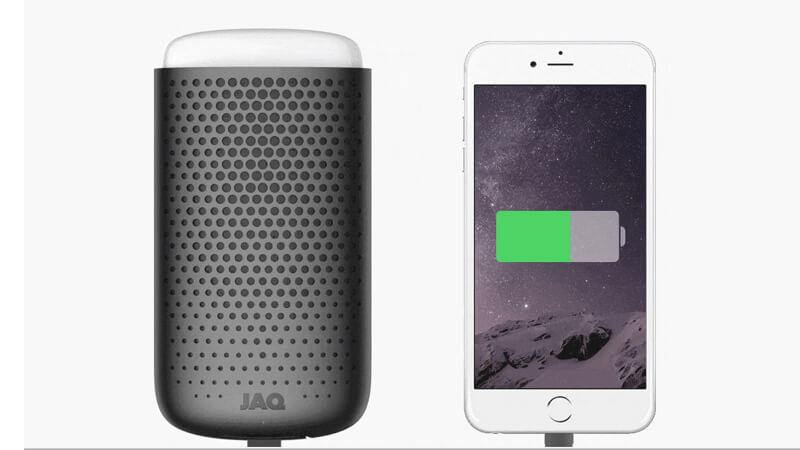
JAQ Portable fuel-cell charger
The JAQ charger is made up of two parts, a rubberised case with a Micro-USB socket – to connect with your mobile device – along with a card containing salt water. When your phone needs a charge, you simply slip the card in the sleeve which breaks a seal that sparks a chemical reaction to produce hydrogen and charge your blower. Each of the slimline cards is the equivalent of a 1,800mAh battery – enough to charge your phone! You’ll need a new card for each charge, but at around £1.50 each it won’t break the bank to slip a few emergency ‘charges’ in your pocket. It’s also certified safe for air travel.
Smartphone charge time: In theory the JAQ will charge your phone in the same time it takes from a regular wall socket or conventional USB source.
Verdict: A great-looking and innovative approach that lets you take control of how many phone charges you carry with you. It’s due to launch soon but you can pre-order now.
How much: £83 (approx) including free charge cards. Additional cards £1.50 (approx).
Where: Pre-order here
OLD-SCHOOL BATTERY POWER…
Alternative energy is great, but we shouldn’t discount traditional battery power.
Battery pros: No need to rely on the elements and other external factors. The AA batteries required are small and easy to carry.
Battery cons: Need to ensure you have batteries.
The Nipper
This is an emergency phone charger that small enough to fit on your keyring and uses traditional AA batteries to ensure you’re always able to give your phone a shot of juice.
How does is work: The following graphic explains how the Nipper works.
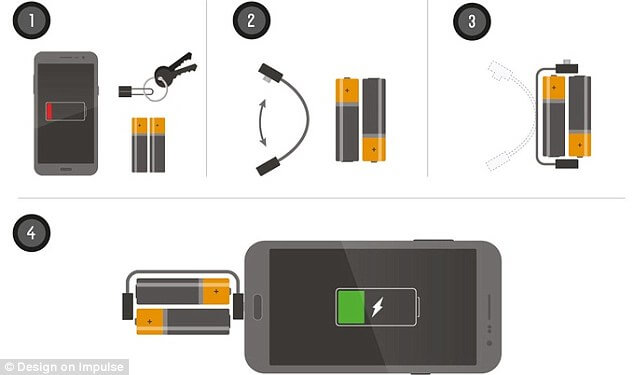
How the Nipper works
Smartphone charge time: The company producing the Nipper has provided details on how much power and talk time a pair of AA batteries will provide for various phones. Click below to view.
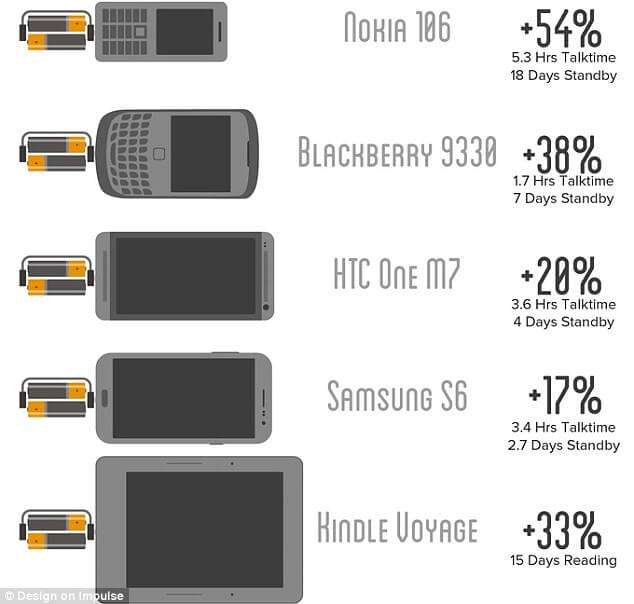
Amount of charge that two AA batteries will give your phone, according to the Nipper’s designers
Verdict: Don’t write-off traditional tech like this – the simple, easy-to-carry charger provides a solution that can go anywhere with with ease. Just remember to change your back-up batteries regularly. Claimed charge capacity could not be tested as the device is still being manufactured.
How much: £14.99
Where: Pre-order here, with deliveries expected in April 2016
Don’t fall off the data radar
Find out how to stay connected when travelling abroad – at a price you’re willing to pay…

Don’t miss the chance to share that shot
There’s little point having a fully charged phone if you can’t get online! Make sure you’re not left floundering in a data dead spot with our guide to getting connected while abroad.
Here are the options…
Get a new sim card
Speak to your phone carrier: Don’t use your mobile for browsing without buying a data bundle or joining a special programme. However, this can be expensive when travelling beyond Europe.
Find out how much your operator will charge: Use this roaming cost tool to find out how much you’ll pay with your carrier.
Best deal: Three customers can get virtually unlimited calls and data usage when travelling in 18 countries around the world with its ‘Feel At Home’ package. If you’re not a Three customer, you can buy a pay-as-you-go sim to bag this deal and enjoy all-you-can-eat data from just £20 for a month. You’ll need an unlocked phone, though (see below for details).
Check out the Three tariffs here
Three’s 18 Feel At Home countries: Here are the countries you’ll get Three’s ultra-cheap international charges as part of its Feel At Home programme.
| Australia Austria Denmark Finland Spain France | Hong Kong Indonesia Israel New Zealand Italy Macau | Norway Republic of Ireland Sri Lanka Switzerland Sweden USA |
Verdict: There’s not a lot to say here! Anyone heading abroad could do worse than take a look at what Three has to offer.
How to unlock your phone: Here’s the information you need for the big phone companies.
EE, Orange and T-Mobile: Start the unlocking process by calling 150 from your handset. It’ll cost £8.99 and take up to 10 days to complete. Pay Monthly customers will also need to be six months into their contract before being able to unlock the device. Pay-as-you-go punters can unlock their phone right away – but it’ll still cost £8.99.
O2: If you’re an O2 customer then contract customers can unlock their phone from day 1 for free. However, pay-as-you-go users will need to wait 12 months before unlocking and it’ll cost £15 (taken from your airtime balance). The unlocking process will take up to 72 hours.
Three: Customers of this carrier will most likely find their device comes unlocked when they buy it. If you have a pre-2014 device, you’ll need to fill in an online form to get it unlocked. The process is free and usually takes just minutes.
Virgin Mobile: Most of this provider’s contract phones are already unlocked from new. However, pay-as-go customers will be charged £15.32 to unlock – but there is no minimum period before this is allowed. If your pay-as-go handset is locked, it could take up to 30 days to get your code to free it up.
Vodafone: From July 2013, all contract and pay-as-you-go handsets were locked to the Vodafone network. Customers on pay-as-you-go deals will need to have owned it for 30 days and pay £19.99 to unlock the phone. Pay monthly users who’ve owned the phone for less than a year will also have to pay £19.99, but it’s free to those who’ve been on contract for more than 12 months. Unlocking will take up to 10 days.
Go MiFi… share your connection
How to stay connected for less when travelling in Europe and beyond…

MiFi from Tep
This is basically a mobile broadband network that runs through a sim card like traditional data. However, instead of connecting to just one phone or needing battery-zapping tethering, the MiFi device acts like your router at home allowing you to simultaneously connect multiple devices.
Can I buy one: Yes, you can buy a device, but you’ll need to buy a local sim card as providers such as Three will not allow you to connect multiple devices to their pay-as-you-go sim cards.
Any other solutions: Yes! There are many companies which hire out these MiFi devices; allowing the whole family or group to connect and enjoy all-you-can-eat data from around £4.50 a day. Once you’ve finished your hols or business trip, simply send the small MiFi device back in the post.
Where can I hire one: Here is just one example of a company that offers this mobile broadband solution…
Tep Wirleless: Tep provides a handheld device you can rent to provide wireless internet access anywhere in the world. With 8 hours’ battery life, it connects up to 5 devices and creates a portable wireless hotspot of around 15 metres. Use it in your appartment, round the pool or at the beach. Connectivity is powered by leading operators around the globe, so expect fast speeds and good coverage.
How much: Check the website for prices, but a week of unlimited data for the family in Australia will cost around £50.
Where: Click here to connect
Wi-Fi enabling apps…
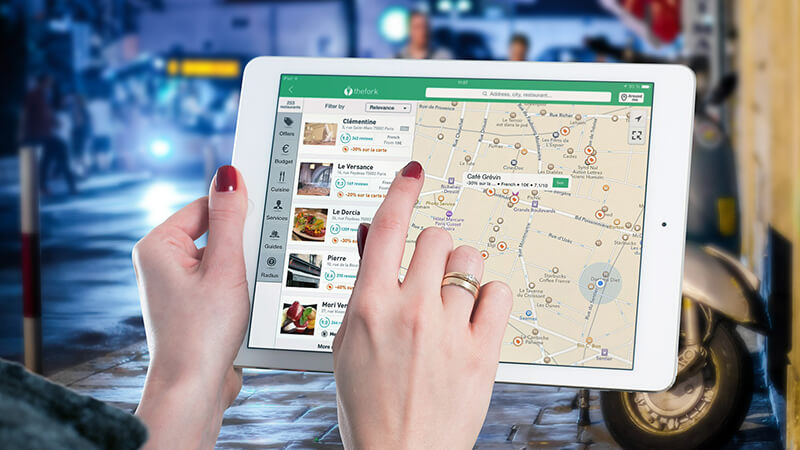
Apps to improve your Wi-Fi experience while aboad
Check out these apps that can help enhance your Wi-Fi experience when travelling.
FLIO
What is it: FLIO lets you dodge the tedium of signing up for airport Wi-Fi each time you arrive in a new location. Simply save your details and the app will do all the dull stuff behind the scenes – leaving you free to get browsing. On top of this, the app will also provide any discounts on food, drinks or shopping in the airport. You’ll also have an instant guide to where to find facilities within the terminal. Another great feature is a live link to all flight information. It’s just been upgraded to work with Android devices, too.
Where to get it: Find more information and download here
Routehappy
What is it: This website lets you check your flight – or prospective flight – for details such as whether the plane will offer Wi-Fi and other essentials such as in-flight entertainment etc. The site will also give each a flight a ‘happiness’ rating. Certainly worth looking at for long-haul flights where you need to stay connected with terra firma.
Where to get it: Simply log on to Routehappy.com here
Free Wi-Fi Hotspots
What is it: Thes app will help you find Wi-Fi hotspots near you. Great for cities and towns when on your hols – and it works offline by using native GPS.
Where to get it:
Apple: Find it here
Android: Find it here
Open Signal:
What is it: Among other things, Open Signal will help locate your nearest cell tower and use a compass to point you in the right direction. Simply walk, or drive towards it to get a signal or improve a weak one. It also helps you locate free local Wi-Fi networks.
Get it here:
Android: Download Open Signal
Apple: Download Open Signal
Wi-Fi around the world
Here’s our at-a-glance guide to free Wi-Fi networks at popular destinations around Europe and beyond…

Connect around the world
Belgium: Click here to reveal
12.8mb/s average download speed
The Brussels Information Technology Service has published a handy map of free WiFi zones throughout Brussels and beyond, so simply head here to find them.
Canada:
11.9mb/s average download speed
Head to high street cafés and restaurants for free Wi-Fi, and there are useful maps online to check for the best free spots to connect with. Use this map to find them where you’re heading.
Denmark:
14.0mb/s average download speed
The Danes use their devices more than any other population, so it follows there’ll be good coverage across the board. Hotels of course, but also look out for free Wi-Fi in libraries and McDonalds. Many trains and buses also provide free access.
France:
8.2mb/s average download speed
Anyone heading to France should expect to find Wi-Fi in the usual suspects, such as restaurants and hotels, but several major cities also offer free municipal connection. Many libraries, town halls and parks will provide a free shot of data. Paris has a public Wi-Fi network, which visitors are free to use at more than 200 public hotspots – including one right next to Notre Dame – for up to two hours at a time. Just hunt for the “Paris Wi-Fi” network on your phone or tablet. There are also similar systems in Bordeaux and Lyon. Find free locations in Paris below…
Germany:
11.5mb/s average download speed
Tough regulation prevents many free Wi-Fi spots operating, but you can find them if you look hard. The networks you do find should be fast and strong.
Find free hotspots here.
Hungary:
10.7mb/s average download speed
Hungry for data? Simply head for cafes and bars. This TripAdviser thread will help with anyone looking to log on in Budapest.
Ireland:
12.4mb/s average download speed
The Irish come an impressive second for average Wi-Fi speed, while many big shops and hotels offer free access. Head to McDonalds, Starbucks and Costa for a quick shot of the free stuff.
Find free Wi-Fi here
Portugal:
10.6mb/s average download speed
The Wi-Fi in Portugal is widespread and mostly free. The city of Porto offers free connectivity on buses and taxis throughout the city.
Spain:
10.4mb/s average download speed
Many cities in Spain now have municipal Wi-Fi networks that are free to use – Barcelona’s city council launched a free Wi-Fi service in 2011, enabling residents and visitors to connect at more than 700 hotspots creating one of the biggest public networks in Europe with thousands more planned for installation. Additionally, free access if offered in 46 airports across the country.
USA:
12.6mb/s average download speed
Along with free Wi-Fi in hotels and restaurants, many truck stops, petrol stations and public libraries provide free Wi-Fi to connect to. Department stores and grocery shops are also good for a quick browse. New York is also about to launch a new super-fast Wi-Fi network built around its obsolete payphones. Browse the US for free Wi-Fi here.
